Abstract
This research investigated the feasibility of using waste-expanded polystyrene (EPS) and mortar to produce lightweight aggregate (LWA). The EPS extracted from the leftover backing waste was crushed into beads using an electric grinder and mixed in three different proportions with two types of mortars (with and without a superplasticizer). Physical property tests such as loose bulk density and water absorption were carried out for the LWA. Also, the compressive strength of the manufactured lightweight aggregate concrete (LWAC) was determined, and failure modes were discussed. The results indicate that using the EPS is effective for LWA. The loose bulk density is obtained at a range from 588 to
1 Introduction
Lightweight concrete (LWC) can be described as a kind of concrete. That includes expanding matters, increasing the mixture’s volume while giving additional qualities such as reducing elements’ self-weight [1]. The dry density of the LWC is 300–1,840 kg/m3, making it 87–23% lighter than traditional concrete [2].
Due to the advantageous properties of LWC, including low density, good thermal insulation, and fire resistance, it has been widely studied as a structural and nonstructural member [3].
The types of LWC are categorized based on production techniques [4]. The first type is called no fines LWC, which is produced by eliminating the fine portion of aggregates [5]. The second type is aerated concrete, which generates air bubbles in the concrete structure by adding chemical additives [6]. The third type is called lightweight aggregate concrete (LWAC), which is usually produced by replacing the conventional aggregate phase fully or partially with lightweight aggregates (LWAs) such as pumice, perlite [7–9], expanded shale [10–12], aggregate concrete made from foam, and ordinary Portland cement [13] and expanded clay [3,14] into the mixture.
LWAs are even natural or artificial [15]; using natural LAWs such as expanded clay instead of conventional aggregate increases the water demand owing to its highly porous structure, causing difficulty in producing an appropriate, consistent mixture [16]. In addition, certain artificial coarse lightweight is obtained through heat treatment, which requires a sintering temperature between 1,000 and
Consequently, the overall construction cost will increase [13]. Therefore, making LWAs that do not consume energy in the production process is very useful. Nevertheless, the most significant advantage of using LWAG is preserving the environment when some materials are reused from industrial wastes or leftovers of product packaging materials [17].
Expanded polystyrene (EPS) is the most popular backing and insulation material; nevertheless, it becomes a waste once used [18]. Statistics show that 14 million tons of EPS is produced yearly, 2.3 million tons of EPS waste is landfilled in the USA, and 300,000 tons of EPS is dumped in the UK yearly [4]. Therefore, EPS is a municipal solid waste (MSW) that requires a sustainable recycling strategy to reduce its negative environmental impact. Several suggested recycling methods include volume reduction, heat treatment (thermal recycling), and chemical recycling [19]. Among (MSWs), the recycle of EPS using the methods mentioned above is high expensive because of its huge air volume which makes it inconvenient through transport [20]. In addition, energy consumption is used by thermal recycling [17].
From a construction point of view, EPS concrete is classified as an artificial concrete with ultra-lightweight [21]. So, it is advantageous to utilize EPS to produce lightweight structures. In addition, it has a nonabsorbent, closed cellular structure, making it a suitable solution to produce adequate consistency without increasing the water demand of the concrete mix. The previous studies introduced EPS concrete by mixing EPS beads randomly in the concrete structure to produce LWC [22,23]. This technique causes several disadvantages during mixing, such as flouting EPS beads; furthermore, the strength reduction increases with the rise of EPS aggregate percentage in the concrete mixture [15,22,24]. This article introduces a novel concept using EPS beads to produce a lightweight man-made aggregate. This concept overcomes the lack of mixing control and high absorption problem and guarantees better strength than other techniques. Also, the produced concrete’s density still meets the standard’s requirements.
2 Materials and methods
2.1 Materials
2.1.1 Cement
Ordinary Portland cement was used throughout this research. The required quantity was brought to the laboratory and stored in a dry place.
2.1.2 Sand
Silica sand was used in this study for two purposes. The first was to produce the concrete, while the second was to produce the LWA using the sand that passes from Sieve No. 16 (1.18 mm).
2.1.3 EPS
The EPS has been prepared in the laboratory using waste material from the market. The EPS was crushed into small granules using an electric grinder to facilitate its addition to cement mortar and obtain a homogenous mixture to produce the LWA (Figure 1).
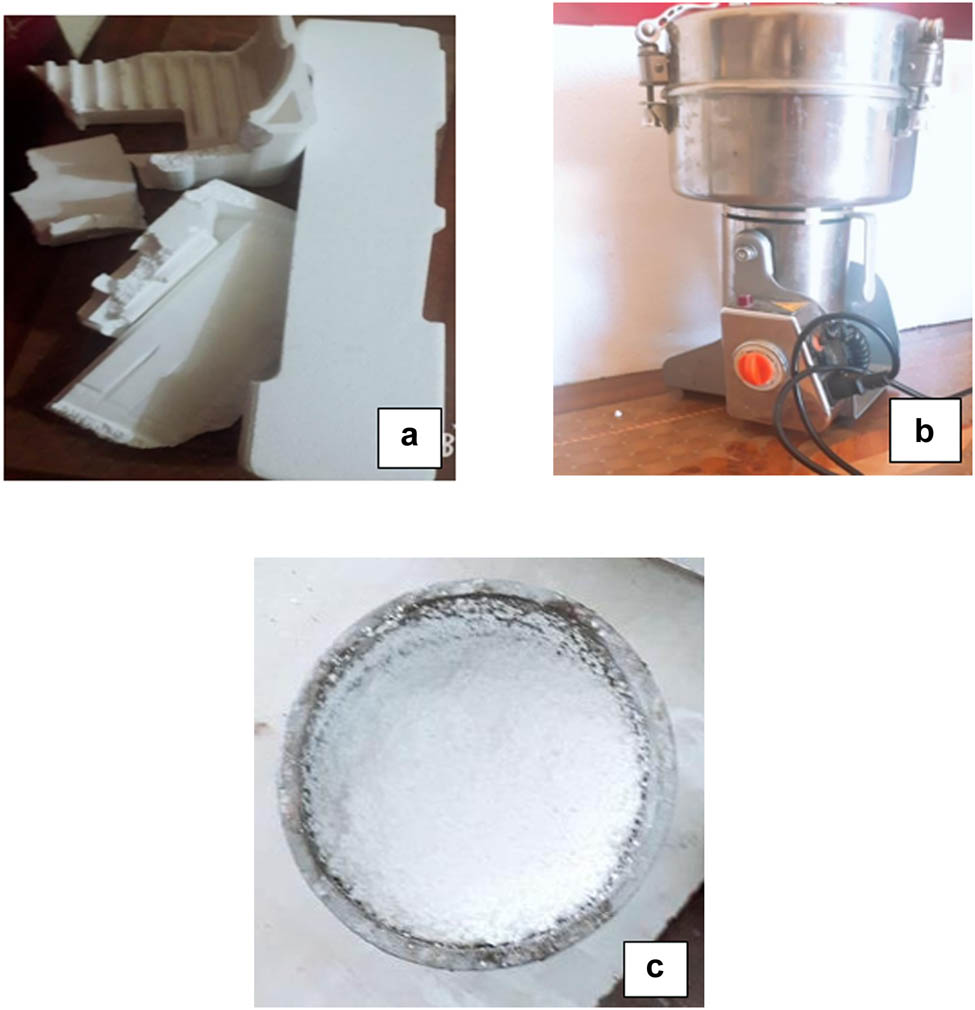
Materials used in the experimental work. (a) Waste EPS, (b) milling machine, and (c) small granules of EPS.
2.1.4 Water
In this study, ordinary potable water was used to produce the cement mortar and LWA for curing purposes.
2.1.5 Superplasticizer concrete admixture
In this study, a high-performance superplasticizer concrete admixture is called SikaViscoCrete-5930. This admixture is a third-generation superplasticizer for concrete and mortar. It complies with the superplasticizer specifications in ASTM-C-494 Types G and F and BS EN 934 Part 2: 2001.
2.2 Preparation of LWAs
In this study, two types of LWAs were prepared:
LWA was made without adding superplasticizer (Groups A, B, and C) to the mortar. The mortar consists of sand with cement at a ratio of 1:1. These ingredients were mixed to obtain a homogeneous mixture and then water was added to the cement with a water-to-cement (W/C) ratio of 0.5. The EPS was then added and mixed at different percentages of EPS/mortar volume (Table 1, Figure 2). The mixture is formed into a spherical LWA and left for 4 to 5 h; curing stage was attained by immersing the aggregates in the water (Figure 4).
The dimensions of the stepped spillway models
| Group | Cement-to-sand ratio | Water-to-cement ratio (w/c) | EPS-to-mortar ratio | Superplasticizer-to-cement ratio % | |
|---|---|---|---|---|---|
| Type (1) | A | 1:1 | 0.5 | 0.5:1 | — |
| B | 1:1 | 0.5 | 1:1 | — | |
| C | 1:1 | 0.5 | 1.5:1 | — | |
| Type (2) | D | 1:1 | 0.5 | 1:1 | 0.25 |
| E | 1:1 | 0.5 | 1.5:1 | 0.25 | |

LWA without superplasticizer.

LWA with superplasticizer.
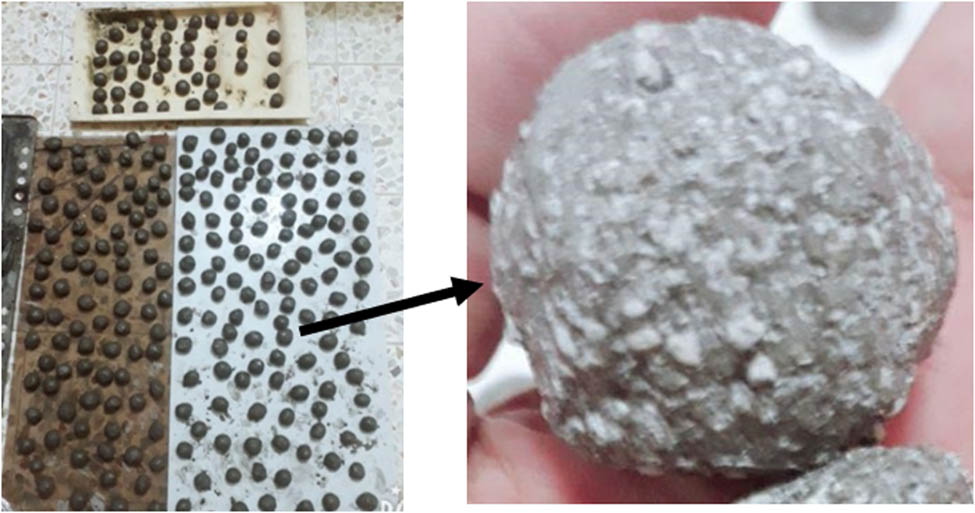
LWA before and after curing.
2.3 Concrete mix
The concrete was conducted by a concrete mix ratio of 1: 1.5: 4 and a W/C ratio of 0.7 with the two types of aggregates (Table 2) and then prepared 6 test cubs for each group, three cubs for the compression test at the age of 7 days and three cubs for the compression test at the age of 28 days. The cubes were with dimensions of
Dimensions of the stepped spillway models
| Group | Mixing ratio | Water cement ratio (w/c) |
|---|---|---|
| A, B, C, D, E | 1:1.5:4 | 0.5 |
2.4 Physical and mechanical properties
2.4.1 Loose bulk density test of aggregates
In this study, the size of LWA being about 20–25 mm, loose bulk density was determined according to ASTM C29/C29M as the aggregate was below the maximum size, 25 mm. The mass of non-compacted aggregates needed to fill a container with a unit volume after aggregates were batch-stored according to volume is known as the loose bulk density. By using the shoveling method, loose bulk density was calculated [25].
2.4.2 Water absorption test
The absorption of water defines as the rise in the mass of LWA because of the penetration of water into the pores of the particles, but not including water adhering to the surface of the particles. It is conducted to calculate the change in aggregate mass due to water absorbed in the pore that is present in the aggregate [26]. According to ASTM C127, 2 kg of LWA is washed and dried before the test sample is placed in the oven at 105
Afterward, LWA is placed in the oven at
2.4.3 Compressive strength
The compressive strength cube test was carried out following the specifications in American society for testing and materials. All cube specimens were marked on the surface and placed in a water-curing tank. The cube of the test was placed centrally on the lower plate of the test machine, with the rough top surface facing outward. The maximum load that could be applied before the cube failed was noted.
3 Results and discussion
3.1 Loose bulk density of LWA
Figure 5 shows the various values of the loose bulk density of LWA depending on its components. The bulk density of LWA value was in the range of 588–790 kg/m3; these values are below the maximum value of 880 kg/m3 permitted [27]. As can be seen, for groups A, B, and C, the density decreased with the increase in EPS content. When the ratio of EPS to mortar in group A is 0.5:1, the density is 790 kg/m3, and when the ratio of EPS to mortar in group C becomes 1.5:1, the density is equal to 645 kg/m3. Group B’s density is between the previous densities because it contains more EPS than group A and less than group C. The same behavior is noted with groups D and E, but with a more decrease in density of the same amount of EPS compared with the previous three groups; this can be explained as a result of changing work steps and because of the use of a superplasticizer. The presence of a superplasticizer made the mixing of EPS with mortar an easy process and did not require high energy, which led to the retention of EPS at most of its original volume and was not subjected to compression and decrease in volume as found in groups A, B, and C (Figures 6 and 7).
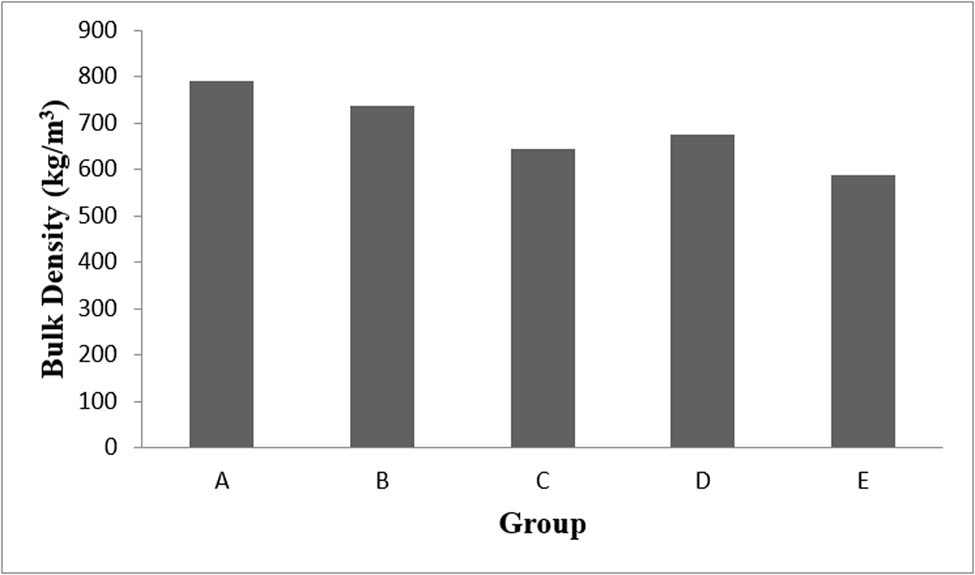
Bulk density of LWA.
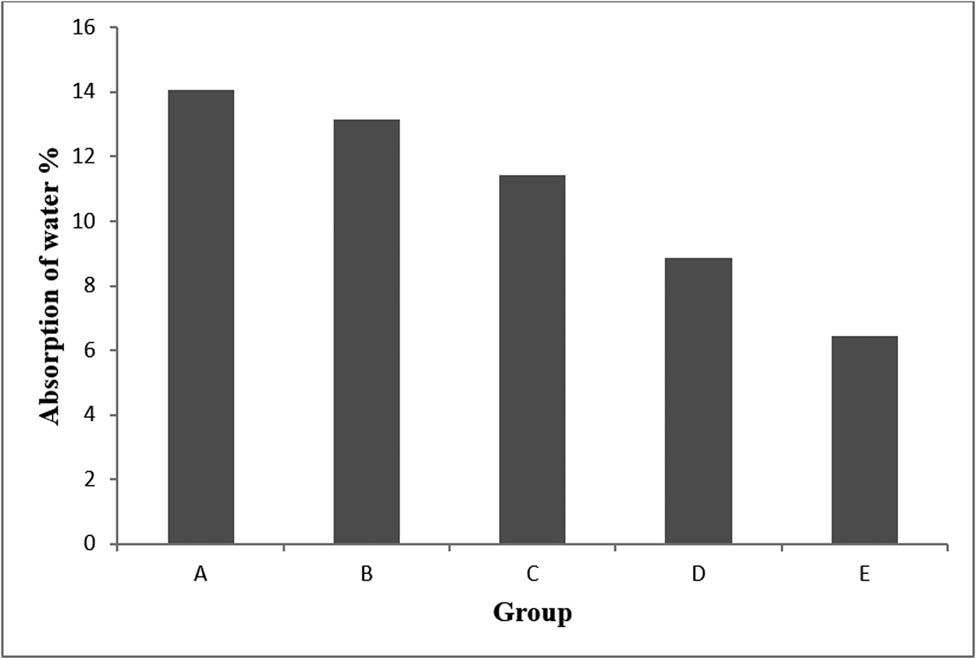
Absorption of LWA.
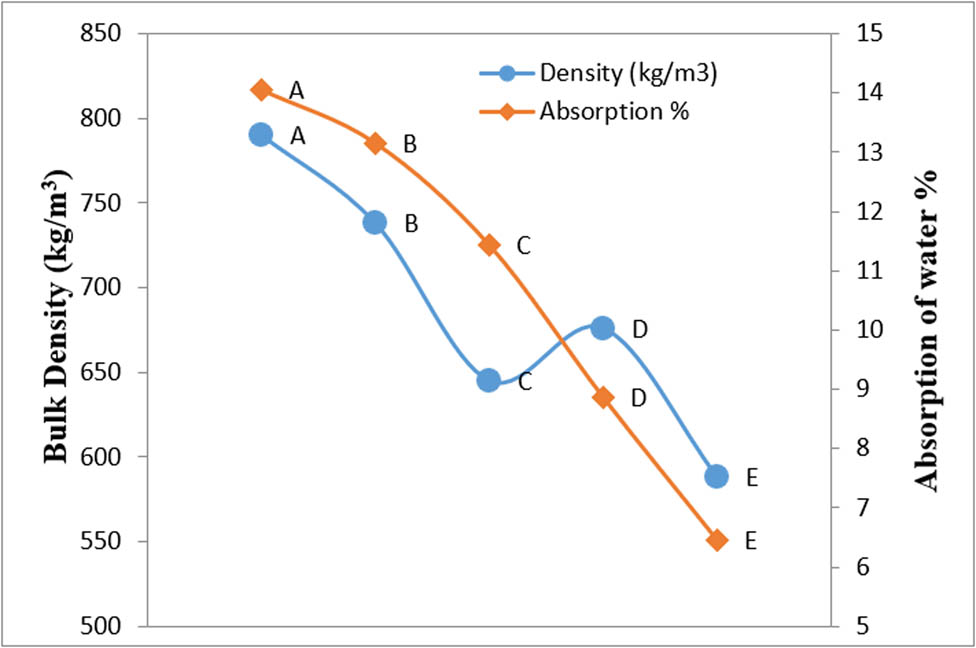
Correlation between density and absorption of LWA.
3.2 Absorption of LWA
Figure 8 shows the various values of water absorption of LWA depending on its components. It is clear that for all groups A, B, C, D, and E, the water absorption decreased with an increased EPS content. Water absorption in group A was 14.05%, which decreased in groups B and C to 13.15 and 11.43%, respectively, because the EPS does not absorb water.
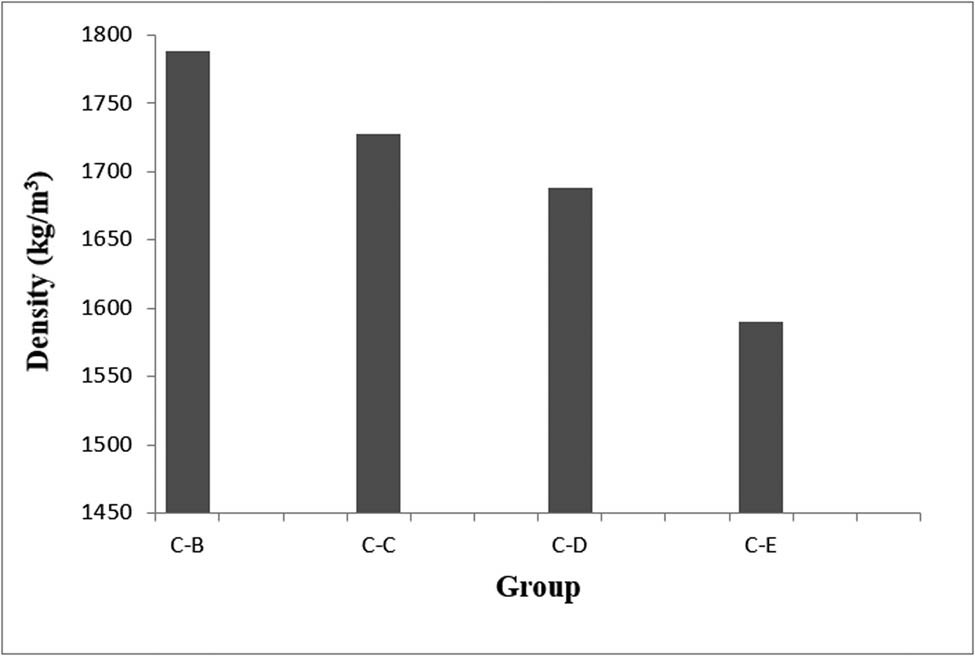
Density of concrete made of LWA.
The same behavior is noted with groups D and E but with a more decrease in water absorption of the same amount of EPS than with the previous three groups. This can be explained as a result of the use of a superplasticizer. The presence of a superplasticizer led to the retention of EPS for most of its original volume and was not subjected to a decrease in volume as in groups A, B, and C. In addition, the presence of a superplasticizer led to a self-compacting process in the mortar. As a result, an additional decrease in mortar voids was observed.
3.3 Correlation between density and absorption
Figure 9 shows the correlation between the density and water absorption of LWA. As shown in Figure 9, the relationship between density and absorption is a direct correlation. This means that the density drop necessarily leads to a decrease in absorption and vice versa. This result can be explained by the fact that LWAs’ density has decreased due to an increase in the proportion of EPS in their composition; as EPS does not absorb water, the LWAs’ water absorption has decreased.
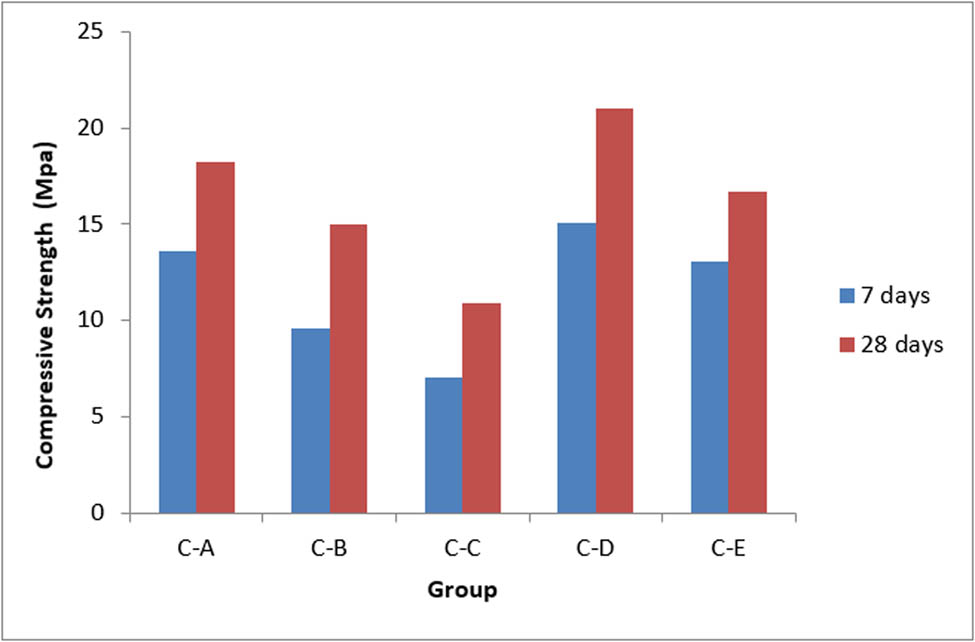
Compressive strength of concrete made of LWA.
3.4 Density of concrete
Figure 8 shows the various values of the density of concrete made of LWA depending on its components. The figure illustrates that all concrete mixtures met the requirements for LWC in terms of density. The density ranged from 1,788 kg/m3 of group C–B to 1,590 kg/m3 of group C–E.
Also, the figure shows that the presence of a superplasticizer significantly impacts concrete density. For the same EPS content (groups C–B and C–D) and (groups C–C and C–E) the presence of superplasticizer made the density of group C–D less than the density of group C–B by 100 kg/m3 and group C–E less than group C-C by 138 kg/m3. In addition, group C–D’s density is less than group C–C’s, although it contains the least amount of EPS of the two groups.
3.5 Compressive strength of concrete
Figure 9 shows the compressive strength of different concrete mixtures. In general, the compressive strength of concrete decreased with an increase in the EPS portion in the aggregate.
This behavior was the same for the two types of aggregates. Also, the compressive strength obtained from concrete made of LWA with superplasticizer was greater than that obtained from the other type. For example, the compressive strength of groups C-D and C-E at 28 days was 21 and 16.6 MPa, which was higher than all other types.
3.6 Correlation between density and compressive strength of concrete
Figure 10 shows the relationship between the density and compressive strength of concrete. The figure shows the decreased compression strength and density for the same aggregate type. The figure also shows that when comparing the concrete made of aggregate types D and E with concrete made of aggregate types A, B, and C, we note that despite the first group having a lower density than that of the second group, these groups show higher compressive strength. This is due to the superplasticizer’s effect, which makes the aggregate structure stiffer, reducing the voids.
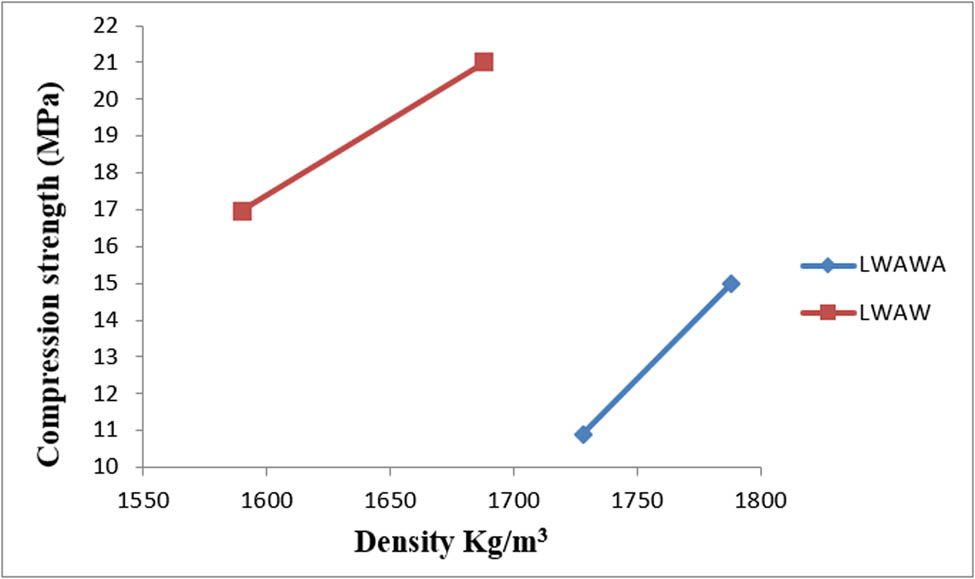
Relationship between density and compression strength of concrete.
3.7 Patterns of failure
Figures 11 and 12 show the failure patterns for both types of concrete. The figure showed that the failure occurred in aggregate at the groups C–A, C–B, and C–C, while the failure occurred in the mortar at the groups C–D and C–E. The failure pattern clearly shows that the LWA made with a superplasticizer was stronger than the LWA made without a superplasticizer, with a significant difference. The failure of concrete with LWA made without superplasticizer occurred in the aggregate, not the mortar. However, the failure occurred for mortar and not aggregate in concrete with LWA with a superplasticizer. This shows that working on a new design to produce a more powerful mortar will increase the compressive strength of concrete made of aggregate content superplasticizer.
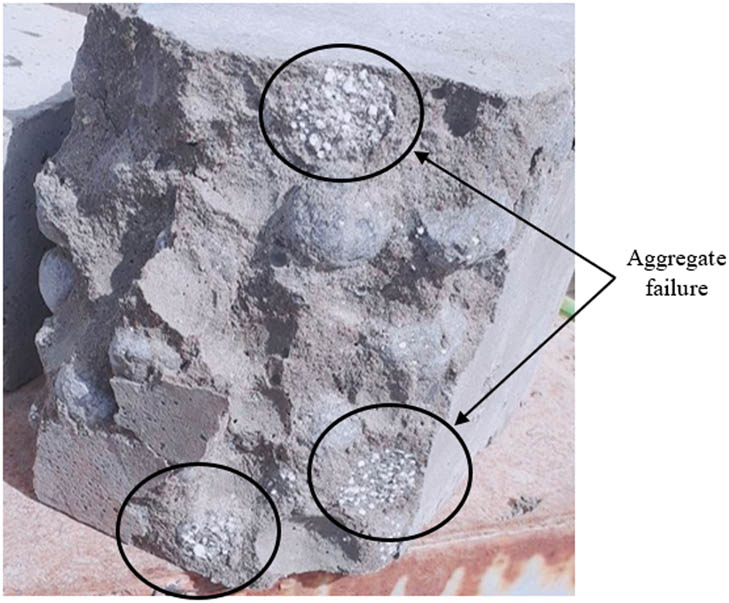
Patterns of failure of concrete made of LWA without Superplasticizer.
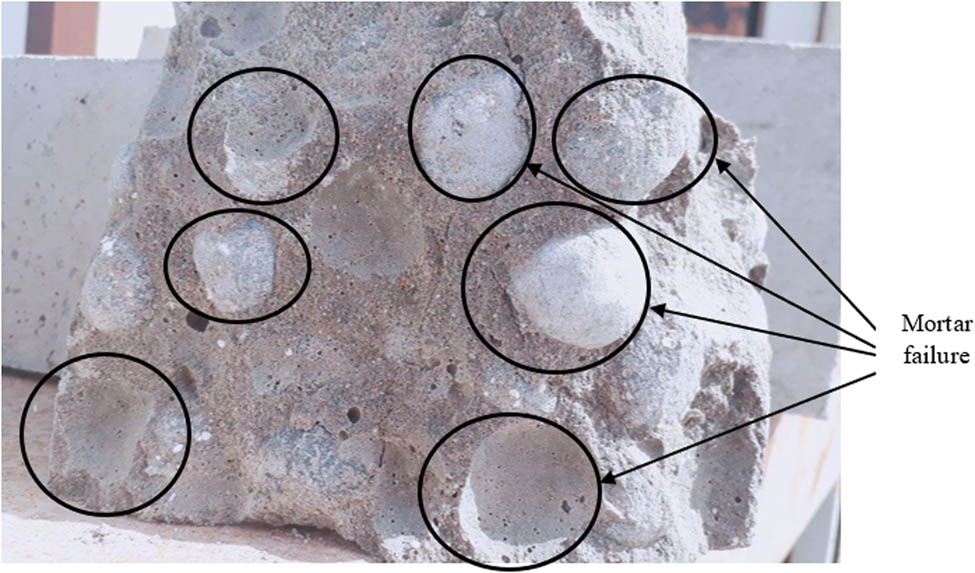
Patterns of failure of concrete made of LWA with Superplasticizer.
4 Conclusion
In this research, a variety of LWAs have been made. All aggregate types are based on EPS. The aggregates were used in the fabrication of LWC samples. A series of tests were conducted on LWAs and LWC. From the current research and with reference to the discussions of the results obtained from the currently conducted experiment, the following conclusions may be drawn to be adopted for further studies:
The use of EPS in the fabrication of coarse aggregates has significantly impacted the production of aggregates with a low density (LWAs). This effect increased when using superplasticizers.
Increasing the amount of EPS mixed with the mortar produces lighter aggregates but is weaker when compressive strength is considered.
Increasing the amount of EPS mixed with the mortar produces lighter aggregates and less water absorbable due to a decrease in the aggregate’s porosity.
When the aggregate used in the concrete fabrication contains more EPS, the result will be that the concrete is lighter, has less compressive strength, and is less absorbent to water.
When a certain amount of EPS is used in producing LWAs, adding the superplasticizer to the production of the aggregates leads to the production of aggregates and concrete that are lighter, stronger, and less water absorbent than that produced without the addition of superplasticizer.
-
Conflict of interest: The authors state no conflict of interest.
-
Data availability statement: Most datasets generated and analyzed in this study are comprised in this submitted manuscript. The other datasets are available on a reasonable request from the corresponding author with the attached information.
References
[1] Zakaria ML. Bahan dan binaan; Dewan Bahasa dan Pustaka Act 1959 (Revised 1978), Kuala Lumpur, Malaysia; 1978. Search in Google Scholar
[2] Ismail KM, Fathi MS, Manaf N. Study of lightweight concrete behaviour. Malaysia: Universiti Teknologi Malaysia; 2004. Search in Google Scholar
[3] Chandra S, Berntsson L. Lightweight aggregate concrete. USA: Elsevier; 2002. 10.1016/B978-081551486-2.50009-2Search in Google Scholar
[4] Herki B, Khatib JM. Valorisation of waste expanded polystyrene in concrete using a novel recycling technique. European J Environ Civil Eng. 2017;21(11):1384–402. 10.1080/19648189.2016.1170729Search in Google Scholar
[5] Ghafoori N, Dutta S. Development of no-fines concrete pavement applications. J Transport Eng. 1995;121(3):283–8. 10.1061/(ASCE)0733-947X(1995)121:3(283)Search in Google Scholar
[6] Zhang X, Zhang H, Gao H, He Y, Jiang M. Effect of bubble feature parameters on rheological properties of fresh concrete. Construct Building Materials. 2019;196:245–55. 10.1016/j.conbuildmat.2018.11.088Search in Google Scholar
[7] Kramar D, Bindiganavile V. Mechanical properties and size effects in lightweight mortars containing expanded perlite aggregate. Materials Structures. 2011;44:735–48. 10.1617/s11527-010-9662-0Search in Google Scholar
[8] Lanzón M, García-Ruiz P. Lightweight cement mortars: advantages and inconveniences of expanded perlite and its influence on fresh and hardened state and durability. Construct Building Materials. 2008;22(8):1798–806. 10.1016/j.conbuildmat.2007.05.006Search in Google Scholar
[9] Lu Z, Xu B, Zhang J, Zhu Y, Sun G, Li Z. Preparation and characterization of expanded perlite/paraffin composite as form-stable phase change material. Solar Energy. 2014;108:460–6. 10.1016/j.solener.2014.08.008Search in Google Scholar
[10] De Gennaro R, Langella A, D’Amore M, Dondi M, Colella A, Cappelletti P, et al. Use of zeolite-rich rocks and waste materials for the production of structural lightweight concretes. Appl Clay Sci. 2008;41(1–2):61–72. 10.1016/j.clay.2007.09.008Search in Google Scholar
[11] Ke Y, Beaucour A, Ortola S, Dumontet H, Cabrillac R. Influence of volume fraction and characteristics of lightweight aggregates on the mechanical properties of concrete. Construct Building Materials. 2009;23(8):2821–8. 10.1016/j.conbuildmat.2009.02.038Search in Google Scholar
[12] Lotfy A, Hossain K, Lachemi M. Lightweight self-consolidating concrete with expanded shale aggregates: Modelling and optimization. Int J Concrete Struct Materials. 2015;9(2):185–206. 10.1007/s40069-015-0096-5Search in Google Scholar
[13] Ibrahim N, Ismail K, Salehuddin S, Amat R, Razak A, Odli Z. Study on characteristics of lightweight aggregate concrete made from foam and ordinary portland cement. In: MATEC Web of Conferences. Vol. 78. Thailand: EDP Sciences; 2016. p. 01105. 10.1051/matecconf/20167801105Search in Google Scholar
[14] Al-Dikheeli MR, Thaib HM, Alasadi LA. Mechanical properties and freeze-thaw resistance of lightweight aggregate concrete using artificial clay aggregate. Open Eng. 2022;12(1):323–31. 10.1515/eng-2022-0019Search in Google Scholar
[15] Reisi M, Mostofinejad D, Emadi H, Nili N. Investigation effects of different parameters on compressive strength and density of EPS concrete. In: 10th International Congress on Advances in Civil Engineering; 2012. p. 1–5. Search in Google Scholar
[16] Khatib J, Herki B, Elkordi A. Characteristics of concrete containing EPS. Use of recycled plastics in eco-efficient concrete. Cambridge, UK: Woodhead Publishing Series in Civil and Structural Engineering; 2019. p. 137–65. 10.1016/B978-0-08-102676-2.00007-4Search in Google Scholar
[17] Rajaeifar MA, Abdi R, Tabatabaei M. Expanded polystyrene waste application for improving biodiesel environmental performance parameters from life cycle assessment point of view. Renew Sustainable Energy Rev. 2017;74:278–98. 10.1016/j.rser.2017.02.032Search in Google Scholar
[18] Sarmiento AM, Guzmán HL, Morales G, Romero DE, Pataquiva-Mateus AY. Expanded polystyrene (EPS) and waste cooking oil (WCO): from urban wastes to potential material of construction. Waste Biomass Valorization. 2016;7:1245–54. 10.1007/s12649-016-9511-7Search in Google Scholar
[19] Kan A, Demirboğa R. A new technique of processing for waste-expanded polystyrene foams as aggregates. J Materials Process Technol. 2009;209(6):2994–3000. 10.1016/j.jmatprotec.2008.07.017Search in Google Scholar
[20] Shin C, Chase GG. Nanofibers from recycle waste expanded polystyrene using natural solvent. Polymer Bulletin. 2005;55:209–15. 10.1007/s00289-005-0421-2Search in Google Scholar
[21] Ayse K, Filiz K. Properties of concrete containing waste expanded polystyrene and natural resin. Construct Building Materials. 2016;105:572–8. 10.1016/j.conbuildmat.2015.12.177Search in Google Scholar
[22] Ramli Sulong NH, Mustapa SAS, Abdul Rashid MK. Application of expanded polystyrene (EPS) in buildings and constructions: A review. J Appl Polymer Sci. 2019;136(20):47529. 10.1002/app.47529Search in Google Scholar
[23] Shabbar R, Al-Tameemi AA, Alhassani AM. The effect of expanded polystyrene beads (EPS) on the physical and mechanical properties of aerated concrete. Open Eng. 2022;12(1):424–30. 10.1515/eng-2022-0020Search in Google Scholar
[24] Schackow A, Effting C, Folgueras MV, Gü ths S, Mendes GA. Mechanical and thermal properties of lightweight concretes with vermiculite and EPS using air-entraining agent. Construct Building Materials. 2014;57:190–7. 10.1016/j.conbuildmat.2014.02.009Search in Google Scholar
[25] Standard A. Standard Test Method for Bulk Density (Unit Weight) and Voids in Aggregate. C29/C29M-2009, 2009, retrieved from http://www.specs4.ihserc.com. Search in Google Scholar
[26] ASTM S. C0127-15, Standard test method for density, relative density (specific gravity), and absorption of coarse aggregate. 2015. Search in Google Scholar
[27] ASTM S. F1869, Specification for lightweight aggregates for structural concrete. ASTM West Conshohocken, PA. 2010. Search in Google Scholar
© 2023 the author(s), published by De Gruyter
This work is licensed under the Creative Commons Attribution 4.0 International License.
Articles in the same Issue
- Regular Articles
- Design optimization of a 4-bar exoskeleton with natural trajectories using unique gait-based synthesis approach
- Technical review of supervised machine learning studies and potential implementation to identify herbal plant dataset
- Effect of ECAP die angle and route type on the experimental evolution, crystallographic texture, and mechanical properties of pure magnesium
- Design and characteristics of two-dimensional piezoelectric nanogenerators
- Hybrid and cognitive digital twins for the process industry
- Discharge predicted in compound channels using adaptive neuro-fuzzy inference system (ANFIS)
- Human factors in aviation: Fatigue management in ramp workers
- LLDPE matrix with LDPE and UV stabilizer additive to evaluate the interface adhesion impact on the thermal and mechanical degradation
- Dislocated time sequences – deep neural network for broken bearing diagnosis
- Estimation method of corrosion current density of RC elements
- A computational iterative design method for bend-twist deformation in composite ship propeller blades for thrusters
- Compressive forces influence on the vibrations of double beams
- Research on dynamical properties of a three-wheeled electric vehicle from the point of view of driving safety
- Risk management based on the best value approach and its application in conditions of the Czech Republic
- Effect of openings on simply supported reinforced concrete skew slabs using finite element method
- Experimental and simulation study on a rooftop vertical-axis wind turbine
- Rehabilitation of overload-damaged reinforced concrete columns using ultra-high-performance fiber-reinforced concrete
- Performance of a horizontal well in a bounded anisotropic reservoir: Part II: Performance analysis of well length and reservoir geometry
- Effect of chloride concentration on the corrosion resistance of pure Zn metal in a 0.0626 M H2SO4 solution
- Numerical and experimental analysis of the heat transfer process in a railway disc brake tested on a dynamometer stand
- Design parameters and mechanical efficiency of jet wind turbine under high wind speed conditions
- Architectural modeling of data warehouse and analytic business intelligence for Bedstead manufacturers
- Influence of nano chromium addition on the corrosion and erosion–corrosion behavior of cupronickel 70/30 alloy in seawater
- Evaluating hydraulic parameters in clays based on in situ tests
- Optimization of railway entry and exit transition curves
- Daily load curve prediction for Jordan based on statistical techniques
- Review Articles
- A review of rutting in asphalt concrete pavement
- Powered education based on Metaverse: Pre- and post-COVID comprehensive review
- A review of safety test methods for new car assessment program in Southeast Asian countries
- Communication
- StarCrete: A starch-based biocomposite for off-world construction
- Special Issue: Transport 2022 - Part I
- Analysis and assessment of the human factor as a cause of occurrence of selected railway accidents and incidents
- Testing the way of driving a vehicle in real road conditions
- Research of dynamic phenomena in a model engine stand
- Testing the relationship between the technical condition of motorcycle shock absorbers determined on the diagnostic line and their characteristics
- Retrospective analysis of the data concerning inspections of vehicles with adaptive devices
- Analysis of the operating parameters of electric, hybrid, and conventional vehicles on different types of roads
- Special Issue: 49th KKBN - Part II
- Influence of a thin dielectric layer on resonance frequencies of square SRR metasurface operating in THz band
- Influence of the presence of a nitrided layer on changes in the ultrasonic wave parameters
- Special Issue: ICRTEEC - 2021 - Part III
- Reverse droop control strategy with virtual resistance for low-voltage microgrid with multiple distributed generation sources
- Special Issue: AESMT-2 - Part II
- Waste ceramic as partial replacement for sand in integral waterproof concrete: The durability against sulfate attack of certain properties
- Assessment of Manning coefficient for Dujila Canal, Wasit/-Iraq
- Special Issue: AESMT-3 - Part I
- Modulation and performance of synchronous demodulation for speech signal detection and dialect intelligibility
- Seismic evaluation cylindrical concrete shells
- Investigating the role of different stabilizers of PVCs by using a torque rheometer
- Investigation of high-turbidity tap water problem in Najaf governorate/middle of Iraq
- Experimental and numerical evaluation of tire rubber powder effectiveness for reducing seepage rate in earth dams
- Enhancement of air conditioning system using direct evaporative cooling: Experimental and theoretical investigation
- Assessment for behavior of axially loaded reinforced concrete columns strengthened by different patterns of steel-framed jacket
- Novel graph for an appropriate cross section and length for cantilever RC beams
- Discharge coefficient and energy dissipation on stepped weir
- Numerical study of the fluid flow and heat transfer in a finned heat sink using Ansys Icepak
- Integration of numerical models to simulate 2D hydrodynamic/water quality model of contaminant concentration in Shatt Al-Arab River with WRDB calibration tools
- Study of the behavior of reactive powder concrete RC deep beams by strengthening shear using near-surface mounted CFRP bars
- The nonlinear analysis of reactive powder concrete effectiveness in shear for reinforced concrete deep beams
- Activated carbon from sugarcane as an efficient adsorbent for phenol from petroleum refinery wastewater: Equilibrium, kinetic, and thermodynamic study
- Structural behavior of concrete filled double-skin PVC tubular columns confined by plain PVC sockets
- Probabilistic derivation of droplet velocity using quadrature method of moments
- A study of characteristics of man-made lightweight aggregate and lightweight concrete made from expanded polystyrene (eps) and cement mortar
- Effect of waste materials on soil properties
- Experimental investigation of electrode wear assessment in the EDM process using image processing technique
- Punching shear of reinforced concrete slabs bonded with reactive powder after exposure to fire
- Deep learning model for intrusion detection system utilizing convolution neural network
- Improvement of CBR of gypsum subgrade soil by cement kiln dust and granulated blast-furnace slag
- Investigation of effect lengths and angles of the control devices below the hydraulic structure
- Finite element analysis for built-up steel beam with extended plate connected by bolts
- Finite element analysis and retrofit of the existing reinforced concrete columns in Iraqi schools by using CFRP as confining technique
- Performing laboratory study of the behavior of reactive powder concrete on the shear of RC deep beams by the drilling core test
- Special Issue: AESMT-4 - Part I
- Depletion zones of groundwater resources in the Southwest Desert of Iraq
- A case study of T-beams with hybrid section shear characteristics of reactive powder concrete
- Feasibility studies and their effects on the success or failure of investment projects. “Najaf governorate as a model”
- Optimizing and coordinating the location of raw material suitable for cement manufacturing in Wasit Governorate, Iraq
- Effect of the 40-PPI copper foam layer height on the solar cooker performance
- Identification and investigation of corrosion behavior of electroless composite coating on steel substrate
- Improvement in the California bearing ratio of subbase soil by recycled asphalt pavement and cement
- Some properties of thermal insulating cement mortar using Ponza aggregate
- Assessment of the impacts of land use/land cover change on water resources in the Diyala River, Iraq
- Effect of varied waste concrete ratios on the mechanical properties of polymer concrete
- Effect of adverse slope on performance of USBR II stilling basin
- Shear capacity of reinforced concrete beams with recycled steel fibers
- Extracting oil from oil shale using internal distillation (in situ retorting)
- Influence of recycling waste hardened mortar and ceramic rubbish on the properties of flowable fill material
- Rehabilitation of reinforced concrete deep beams by near-surface-mounted steel reinforcement
- Impact of waste materials (glass powder and silica fume) on features of high-strength concrete
- Studying pandemic effects and mitigation measures on management of construction projects: Najaf City as a case study
- Design and implementation of a frequency reconfigurable antenna using PIN switch for sub-6 GHz applications
- Average monthly recharge, surface runoff, and actual evapotranspiration estimation using WetSpass-M model in Low Folded Zone, Iraq
- Simple function to find base pressure under triangular and trapezoidal footing with two eccentric loads
- Assessment of ALINEA method performance at different loop detector locations using field data and micro-simulation modeling via AIMSUN
- Special Issue: AESMT-5 - Part I
- Experimental and theoretical investigation of the structural behavior of reinforced glulam wooden members by NSM steel bars and shear reinforcement CFRP sheet
- Improving the fatigue life of composite by using multiwall carbon nanotubes
- A comparative study to solve fractional initial value problems in discrete domain
- Assessing strength properties of stabilized soils using dynamic cone penetrometer test
- Investigating traffic characteristics for merging sections in Iraq
- Enhancement of flexural behavior of hybrid flat slab by using SIFCON
- The main impacts of a managed aquifer recharge using AHP-weighted overlay analysis based on GIS in the eastern Wasit province, Iraq
Articles in the same Issue
- Regular Articles
- Design optimization of a 4-bar exoskeleton with natural trajectories using unique gait-based synthesis approach
- Technical review of supervised machine learning studies and potential implementation to identify herbal plant dataset
- Effect of ECAP die angle and route type on the experimental evolution, crystallographic texture, and mechanical properties of pure magnesium
- Design and characteristics of two-dimensional piezoelectric nanogenerators
- Hybrid and cognitive digital twins for the process industry
- Discharge predicted in compound channels using adaptive neuro-fuzzy inference system (ANFIS)
- Human factors in aviation: Fatigue management in ramp workers
- LLDPE matrix with LDPE and UV stabilizer additive to evaluate the interface adhesion impact on the thermal and mechanical degradation
- Dislocated time sequences – deep neural network for broken bearing diagnosis
- Estimation method of corrosion current density of RC elements
- A computational iterative design method for bend-twist deformation in composite ship propeller blades for thrusters
- Compressive forces influence on the vibrations of double beams
- Research on dynamical properties of a three-wheeled electric vehicle from the point of view of driving safety
- Risk management based on the best value approach and its application in conditions of the Czech Republic
- Effect of openings on simply supported reinforced concrete skew slabs using finite element method
- Experimental and simulation study on a rooftop vertical-axis wind turbine
- Rehabilitation of overload-damaged reinforced concrete columns using ultra-high-performance fiber-reinforced concrete
- Performance of a horizontal well in a bounded anisotropic reservoir: Part II: Performance analysis of well length and reservoir geometry
- Effect of chloride concentration on the corrosion resistance of pure Zn metal in a 0.0626 M H2SO4 solution
- Numerical and experimental analysis of the heat transfer process in a railway disc brake tested on a dynamometer stand
- Design parameters and mechanical efficiency of jet wind turbine under high wind speed conditions
- Architectural modeling of data warehouse and analytic business intelligence for Bedstead manufacturers
- Influence of nano chromium addition on the corrosion and erosion–corrosion behavior of cupronickel 70/30 alloy in seawater
- Evaluating hydraulic parameters in clays based on in situ tests
- Optimization of railway entry and exit transition curves
- Daily load curve prediction for Jordan based on statistical techniques
- Review Articles
- A review of rutting in asphalt concrete pavement
- Powered education based on Metaverse: Pre- and post-COVID comprehensive review
- A review of safety test methods for new car assessment program in Southeast Asian countries
- Communication
- StarCrete: A starch-based biocomposite for off-world construction
- Special Issue: Transport 2022 - Part I
- Analysis and assessment of the human factor as a cause of occurrence of selected railway accidents and incidents
- Testing the way of driving a vehicle in real road conditions
- Research of dynamic phenomena in a model engine stand
- Testing the relationship between the technical condition of motorcycle shock absorbers determined on the diagnostic line and their characteristics
- Retrospective analysis of the data concerning inspections of vehicles with adaptive devices
- Analysis of the operating parameters of electric, hybrid, and conventional vehicles on different types of roads
- Special Issue: 49th KKBN - Part II
- Influence of a thin dielectric layer on resonance frequencies of square SRR metasurface operating in THz band
- Influence of the presence of a nitrided layer on changes in the ultrasonic wave parameters
- Special Issue: ICRTEEC - 2021 - Part III
- Reverse droop control strategy with virtual resistance for low-voltage microgrid with multiple distributed generation sources
- Special Issue: AESMT-2 - Part II
- Waste ceramic as partial replacement for sand in integral waterproof concrete: The durability against sulfate attack of certain properties
- Assessment of Manning coefficient for Dujila Canal, Wasit/-Iraq
- Special Issue: AESMT-3 - Part I
- Modulation and performance of synchronous demodulation for speech signal detection and dialect intelligibility
- Seismic evaluation cylindrical concrete shells
- Investigating the role of different stabilizers of PVCs by using a torque rheometer
- Investigation of high-turbidity tap water problem in Najaf governorate/middle of Iraq
- Experimental and numerical evaluation of tire rubber powder effectiveness for reducing seepage rate in earth dams
- Enhancement of air conditioning system using direct evaporative cooling: Experimental and theoretical investigation
- Assessment for behavior of axially loaded reinforced concrete columns strengthened by different patterns of steel-framed jacket
- Novel graph for an appropriate cross section and length for cantilever RC beams
- Discharge coefficient and energy dissipation on stepped weir
- Numerical study of the fluid flow and heat transfer in a finned heat sink using Ansys Icepak
- Integration of numerical models to simulate 2D hydrodynamic/water quality model of contaminant concentration in Shatt Al-Arab River with WRDB calibration tools
- Study of the behavior of reactive powder concrete RC deep beams by strengthening shear using near-surface mounted CFRP bars
- The nonlinear analysis of reactive powder concrete effectiveness in shear for reinforced concrete deep beams
- Activated carbon from sugarcane as an efficient adsorbent for phenol from petroleum refinery wastewater: Equilibrium, kinetic, and thermodynamic study
- Structural behavior of concrete filled double-skin PVC tubular columns confined by plain PVC sockets
- Probabilistic derivation of droplet velocity using quadrature method of moments
- A study of characteristics of man-made lightweight aggregate and lightweight concrete made from expanded polystyrene (eps) and cement mortar
- Effect of waste materials on soil properties
- Experimental investigation of electrode wear assessment in the EDM process using image processing technique
- Punching shear of reinforced concrete slabs bonded with reactive powder after exposure to fire
- Deep learning model for intrusion detection system utilizing convolution neural network
- Improvement of CBR of gypsum subgrade soil by cement kiln dust and granulated blast-furnace slag
- Investigation of effect lengths and angles of the control devices below the hydraulic structure
- Finite element analysis for built-up steel beam with extended plate connected by bolts
- Finite element analysis and retrofit of the existing reinforced concrete columns in Iraqi schools by using CFRP as confining technique
- Performing laboratory study of the behavior of reactive powder concrete on the shear of RC deep beams by the drilling core test
- Special Issue: AESMT-4 - Part I
- Depletion zones of groundwater resources in the Southwest Desert of Iraq
- A case study of T-beams with hybrid section shear characteristics of reactive powder concrete
- Feasibility studies and their effects on the success or failure of investment projects. “Najaf governorate as a model”
- Optimizing and coordinating the location of raw material suitable for cement manufacturing in Wasit Governorate, Iraq
- Effect of the 40-PPI copper foam layer height on the solar cooker performance
- Identification and investigation of corrosion behavior of electroless composite coating on steel substrate
- Improvement in the California bearing ratio of subbase soil by recycled asphalt pavement and cement
- Some properties of thermal insulating cement mortar using Ponza aggregate
- Assessment of the impacts of land use/land cover change on water resources in the Diyala River, Iraq
- Effect of varied waste concrete ratios on the mechanical properties of polymer concrete
- Effect of adverse slope on performance of USBR II stilling basin
- Shear capacity of reinforced concrete beams with recycled steel fibers
- Extracting oil from oil shale using internal distillation (in situ retorting)
- Influence of recycling waste hardened mortar and ceramic rubbish on the properties of flowable fill material
- Rehabilitation of reinforced concrete deep beams by near-surface-mounted steel reinforcement
- Impact of waste materials (glass powder and silica fume) on features of high-strength concrete
- Studying pandemic effects and mitigation measures on management of construction projects: Najaf City as a case study
- Design and implementation of a frequency reconfigurable antenna using PIN switch for sub-6 GHz applications
- Average monthly recharge, surface runoff, and actual evapotranspiration estimation using WetSpass-M model in Low Folded Zone, Iraq
- Simple function to find base pressure under triangular and trapezoidal footing with two eccentric loads
- Assessment of ALINEA method performance at different loop detector locations using field data and micro-simulation modeling via AIMSUN
- Special Issue: AESMT-5 - Part I
- Experimental and theoretical investigation of the structural behavior of reinforced glulam wooden members by NSM steel bars and shear reinforcement CFRP sheet
- Improving the fatigue life of composite by using multiwall carbon nanotubes
- A comparative study to solve fractional initial value problems in discrete domain
- Assessing strength properties of stabilized soils using dynamic cone penetrometer test
- Investigating traffic characteristics for merging sections in Iraq
- Enhancement of flexural behavior of hybrid flat slab by using SIFCON
- The main impacts of a managed aquifer recharge using AHP-weighted overlay analysis based on GIS in the eastern Wasit province, Iraq

